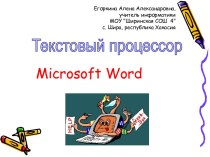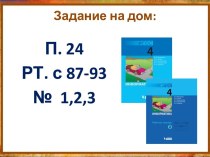- Главная
- Разное
- Бизнес и предпринимательство
- Образование
- Развлечения
- Государство
- Спорт
- Графика
- Культурология
- Еда и кулинария
- Лингвистика
- Религиоведение
- Черчение
- Физкультура
- ИЗО
- Психология
- Социология
- Английский язык
- Астрономия
- Алгебра
- Биология
- География
- Геометрия
- Детские презентации
- Информатика
- История
- Литература
- Маркетинг
- Математика
- Медицина
- Менеджмент
- Музыка
- МХК
- Немецкий язык
- ОБЖ
- Обществознание
- Окружающий мир
- Педагогика
- Русский язык
- Технология
- Физика
- Философия
- Химия
- Шаблоны, картинки для презентаций
- Экология
- Экономика
- Юриспруденция
Что такое findslide.org?
FindSlide.org - это сайт презентаций, докладов, шаблонов в формате PowerPoint.
Обратная связь
Email: Нажмите что бы посмотреть
Презентация на тему AVT. Audiovisual Translation
Содержание
- 2. AV (audiovisual) text- a communication act involving sounds and images
- 3. AVTencapsulates different translation practices used in the
- 4. Main Types of AVTdubbing, subtitling, voice-over
- 5. Types- partial-dubbing- the translation of live performance-
- 6. Subtitling- a translation practice that consists of
- 7. Classification of SubtitlesCriteria linguistic parameterstime available for preparationtechnical parametersmethods of projectiondistribution format
- 8. Linguistic parameters
- 9. Time available for preparation
- 10. Technical parameters Open subtitlesClosed subtitles
- 11. Methods of projecting subtitles
- 12. Distribution Format
- 13. SurtitleAt an opera or play that is
- 14. List of events where surtitles can be used
- 15. IntertitlesIntertitles are at the origin of subtitles
- 16. FansubsThe origins of fansubbing go back to
- 17. The translations are done for free by
- 18. Subtitling process1. REGISTRATION– of programme
- 19. 6. ADAPTATION – of
- 20. ProfessionalsThe spotter – known by some companies
- 21. The
- 22. Adaptors are experts in the media limitations
- 23. Dubbing- Example of the invisibility of translation,
- 24. Types of synchronylip-synckinesic synchronyisochrony
- 25. Quality standards that help to maintain the impression of reality
- 26. Translation techniques
- 27. Synchronisationconsists of matching the TL translation with
- 28. Lip-sync- a type of synchronisation, which consists
- 29. Kinesic synchronya type of synchronisation, which consists
- 30. IsochronyMouth articulation movements are directly related to
- 32. Techniques
- 36. Скачать презентацию
- 37. Похожие презентации
AV (audiovisual) text- a communication act involving sounds and images








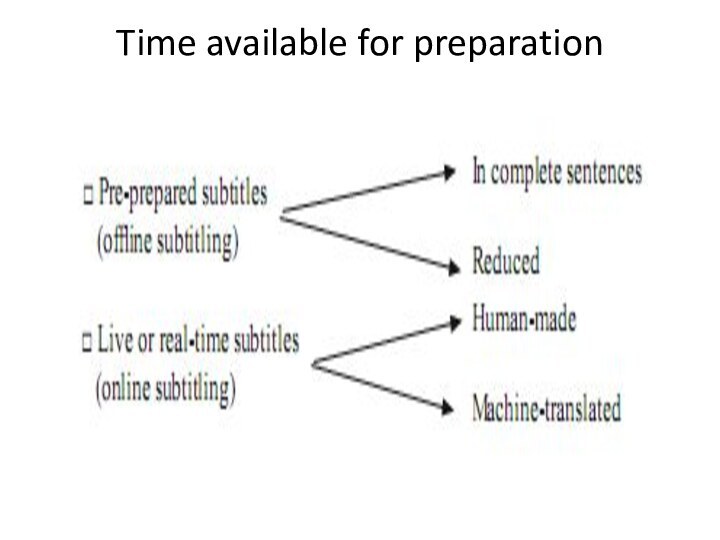











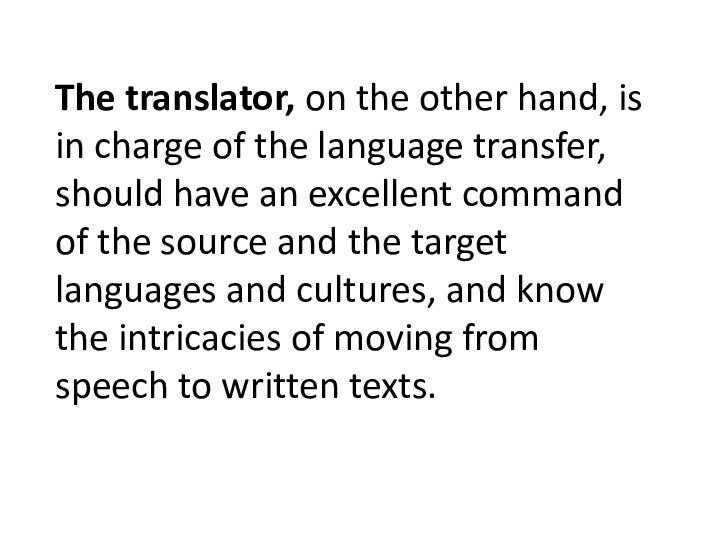




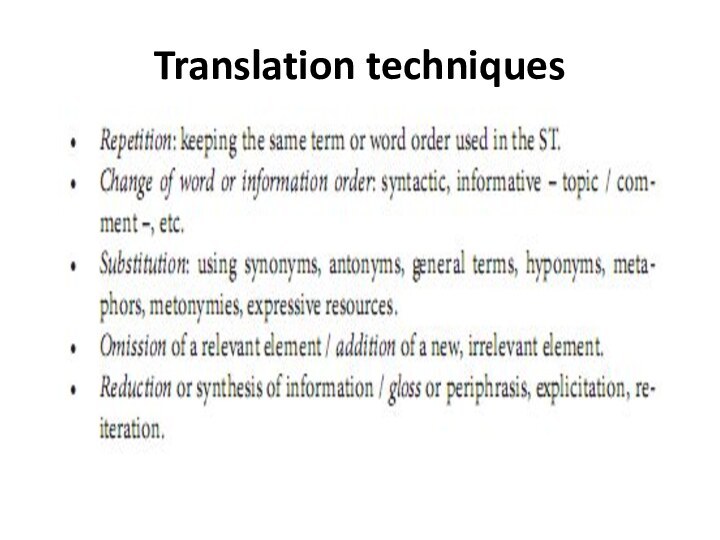

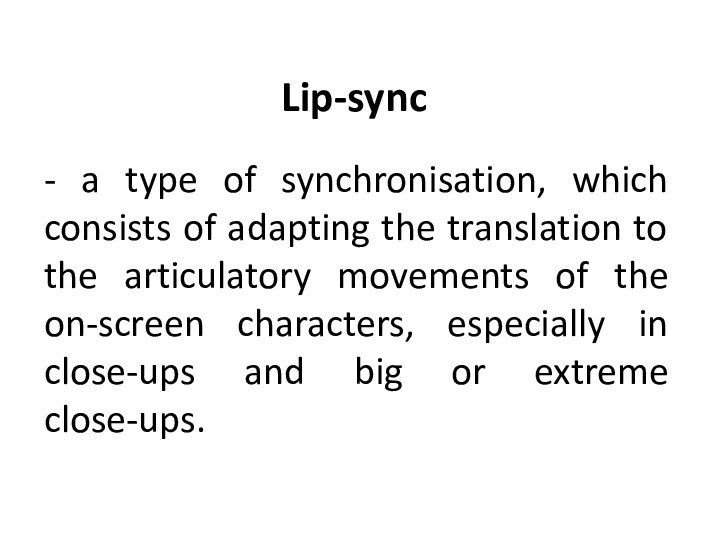








Слайд 3
AVT
encapsulates different translation practices
used in the audiovisual
media – cinema, television, VHS – in which there
isa transfer from a source to a target language, which involves some form of
interaction with sound and images.
Слайд 5
Types
- partial-dubbing
- the translation of live performance
- surtitling
for the opera and the theatre
subtitling for the deaf
and the hard-of-hearing (SDH)audio description for the blind and the partially sighted (AD)
Слайд 6
Subtitling
- a translation practice that consists of presenting
a written text, generally on the lower part of
the screen, that endeavours to recount the original dialogue of the speakers, as well as the discursive elements that appear in the image (letters, inserts, graffiti, inscriptions, placards, and the like), and the information that is contained on the soundtrack (songs, voices off).
Слайд 7
Classification of Subtitles
Criteria
linguistic parameters
time available for preparation
technical
parameters
methods of projection
distribution format
Слайд 13
Surtitle
At an opera or play that is being
performed in a foreign language, surtitles are a translation
or summary of the words, which appear on a screen above the stage.Surtitle образовано с помощью приставки sur (= above — над) и слова title (заголовок, титр), так же как и слово subtitle (субтитр), в котором приставка sub = below (под). К концу 1980-х гг. слово surtitle укоренилось в Англии и стало использоваться как в связи с постановкой пьес на иностранных языках, так и в связи с постановкой опер. В американском варианте surtitle = supertitle .
Слайд 15
Intertitles
Intertitles are at the origin of subtitles and
can be considered their oldest relatives, the first experiments
with intertitles having taken place in the early 20th century. They are also known as ‘title cards’ and can be defined as a piece of filmed, printed text that appears between scenes. They were a mainstay of silent films and consisted of short sentences written against a dark background, usually white on black. Their main functions were to convey character dialogue and descriptive narrative material related to the images. Although communicative in essence, some directors also used them as an artistic and expressive device.The arrival of the soundtrack largely eliminated their usefulness, and when they are used in contemporary films they tend to be called inserts.
Слайд 16
Fansubs
The origins of fansubbing go back to the
1980s, when it emerged as an attempt to popularize
the Japanese cartoons known as manga and anime.American and European fans wanted to watch their favourite programmes but were faced with two main problems: on the one hand, the linguistic barrier and on the other, the scant distribution of these series in their respective countries. The alternative option was to subtitle these programmes themselves.
Слайд 17 The translations are done for free by aficionados
of these programmes and then posted on the Internet
so that anyone who is interested may watch them. This new form of subtitling ‘by fans for fans’ lies at the margins of market imperatives and is far less dogmatic and more creative and individualistic than what has traditionally been done. Some of its defining features are the use of colours to identify speakers, the incorporation of explicative glosses and metalinguistic notes in the subtitles themselves or on the top of the screen, and the use of cumulative subtitles. In fact, some aficionados prefer to use the term subbing, instead of subtitling, in order to emphasize the peculiar nature of the activity.
Слайд 18
Subtitling process
1. REGISTRATION
– of programme information
2.
VERIFICATION
– of master and dialogue list
3.
PRODUCTION– of a time-coded working copy
4. SPOTTING
– marking the time of the beginning and the end of an utterance
5. RAW TRANSLATION
– the dialogue list is rewritten in TL with no or only minimal reference to lip movements
Слайд 19 6. ADAPTATION – of the first version
of the translation, paying attention to the lip movement,
intonation, gestures and mimics 7. CASTING – of the actors, who will perform in the dubbed version 8. RECORDING 9. PRELIMINARY MIX AND EDIT – of the soundtrack 10. FINAL MIX 11. APPROVAL 12. TRANSMISSION – admission to distribution
Слайд 20
Professionals
The spotter – known by some companies as
subtitler – is responsible for the technical task of
deciding the in and out times of the subtitles, and increasingly for creating templates and master titles with relevant annotations for the translators.Слайд 21 The translator, on the other hand, is in
charge of the language transfer, should have an excellent
command of the source and the target languages and cultures, and know the intricacies of moving from speech to written texts.Слайд 22 Adaptors are experts in the media limitations that
constrain subtitling and are familiar with condensation and reduction
strategies in the target language. Their role is to fit the rough translation into the subtitle lines, searching for shorter synonyms and altering syntactical structures without sacrificing the meaning of the original, although in some cases they might have no knowledge of the source language.
Слайд 23
Dubbing
- Example of the invisibility of translation, an
artistic and
technical exercise which consciously erases the original dialogue
track and substitutes it for another track in which target language (TL) dialogue exchanges are recorded. Contrary to voice-over, for example, emphasis is placed on matching the translation with the soundless mouths of original actors. The result is that
viewers watch and hear foreign actors speaking in their own domestic language, a paradox which has been naturally accepted in all dubbing countries.
Слайд 27
Synchronisation
consists of matching the TL translation with the
articulatory and body movements of the screen actors, as
well as matching the utterances and pausesIn the translation with those of the ST.
Слайд 28
Lip-sync
- a type of synchronisation, which consists of
adapting the translation to the articulatory movements of the
on-screen characters, especially in close-ups and big or extreme close-ups.
Слайд 29
Kinesic synchrony
a type of synchronisation, which consists of
making the meaning of kinesic signs explicit, either because
understanding them is essential (a functional need),or because missing them would result in waking up from the cinematographic dream consciously agreed between the film and the viewer.Sometimes, kinesic signs are accompanied by (redundant) words which make their meaning explicit. Some other times they appear alone, with no spoken word, caption, sound or some other icon that explains them.



